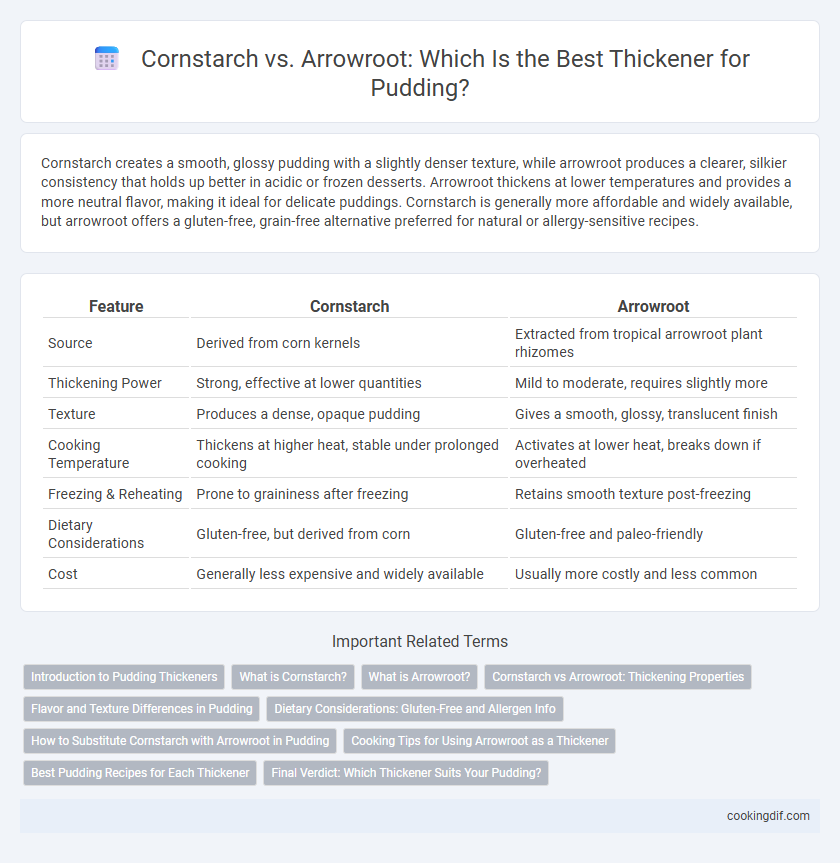Cornstarch creates a smooth, glossy pudding with a slightly denser texture, while arrowroot produces a clearer, silkier consistency that holds up better in acidic or frozen desserts. Arrowroot thickens at lower temperatures and provides a more neutral flavor, making it ideal for delicate puddings. Cornstarch is generally more affordable and widely available, but arrowroot offers a gluten-free, grain-free alternative preferred for natural or allergy-sensitive recipes.
Table of Comparison
| Feature | Cornstarch | Arrowroot |
|---|---|---|
| Source | Derived from corn kernels | Extracted from tropical arrowroot plant rhizomes |
| Thickening Power | Strong, effective at lower quantities | Mild to moderate, requires slightly more |
| Texture | Produces a dense, opaque pudding | Gives a smooth, glossy, translucent finish |
| Cooking Temperature | Thickens at higher heat, stable under prolonged cooking | Activates at lower heat, breaks down if overheated |
| Freezing & Reheating | Prone to graininess after freezing | Retains smooth texture post-freezing |
| Dietary Considerations | Gluten-free, but derived from corn | Gluten-free and paleo-friendly |
| Cost | Generally less expensive and widely available | Usually more costly and less common |
Introduction to Pudding Thickeners
Cornstarch and arrowroot serve as popular pudding thickeners, each offering distinct textures and properties. Cornstarch creates a glossy, firm consistency ideal for classic custards, while arrowroot provides a clear, smooth finish suitable for delicate flavors. Choosing the right thickener depends on the desired pudding texture, cooking temperature, and dietary preferences.
What is Cornstarch?
Cornstarch is a fine, powdery starch derived from the endosperm of corn kernels, commonly used as a thickening agent in puddings due to its strong gelatinization properties. It forms a translucent, smooth texture when cooked and thickens liquids rapidly at temperatures around 144-162degF (62-72degC). Unlike arrowroot, cornstarch can break down if overheated or overcooked, affecting the final pudding consistency.
What is Arrowroot?
Arrowroot is a natural starch extracted from the rhizomes of tropical plants, primarily used as a gluten-free thickening agent in pudding. It creates a clear, glossy texture and imparts a smooth consistency, making it ideal for delicate desserts. Unlike cornstarch, arrowroot works well at lower temperatures and does not break down when combined with acidic ingredients.
Cornstarch vs Arrowroot: Thickening Properties
Cornstarch and arrowroot both act as effective pudding thickeners, but cornstarch creates a glossy, translucent texture while arrowroot produces a clearer, more delicate gel. Cornstarch thickens quickly at higher temperatures and provides a smooth, stable consistency that holds up well in reheating. Arrowroot thickens at lower temperatures and maintains its thickening power without breaking down in acidic mixtures, making it ideal for fruit-based puddings.
Flavor and Texture Differences in Pudding
Cornstarch imparts a creamy, slightly opaque texture with a neutral flavor, enhancing pudding's smoothness and body. Arrowroot creates a clearer, glossy pudding with a lighter, silkier mouthfeel and a subtle, slightly earthy taste. Choosing between cornstarch and arrowroot affects the pudding's final consistency and flavor profile, with cornstarch providing thickness and opacity, while arrowroot offers translucence and a delicate finish.
Dietary Considerations: Gluten-Free and Allergen Info
Cornstarch and arrowroot are both gluten-free thickeners commonly used in pudding recipes, making them suitable for individuals with gluten sensitivities or celiac disease. Arrowroot is often preferred for those with corn allergies or sensitivities, as it is derived from tropical plant roots rather than corn. Both thickeners are hypoallergenic but arrowroot provides a more neutral flavor and clearer finish, which can enhance the texture and appearance of gluten-free puddings.
How to Substitute Cornstarch with Arrowroot in Pudding
To substitute cornstarch with arrowroot in pudding, use a 1:1 ratio as arrowroot has similar thickening power but creates a clearer, glossier texture. Dissolve arrowroot in a small amount of cold liquid before adding it to the hot pudding mixture to prevent clumping and ensure smooth consistency. Arrowroot thickens at lower temperatures and loses effectiveness if overheated, so add it near the end of cooking and avoid boiling.
Cooking Tips for Using Arrowroot as a Thickener
Arrowroot provides a clear, glossy finish to pudding and thickens at lower temperatures than cornstarch, making it ideal for delicate recipes. To use arrowroot effectively, dissolve it in cold water before adding it to warm liquids to prevent clumping and avoid boiling the pudding after thickening, as high heat can break down its thickening properties. Arrowroot also works well with acidic ingredients and freezes better than cornstarch-thickened puddings, maintaining smooth texture after thawing.
Best Pudding Recipes for Each Thickener
Cornstarch creates a silky, dense pudding ideal for classic vanilla or chocolate recipes due to its strong thickening power and smooth texture. Arrowroot produces a clearer, more delicate pudding perfect for fruit-based or tropical flavors, preserving brightness and offering a glossy finish. Each thickener enhances the pudding's consistency uniquely, with cornstarch best for creamy richness and arrowroot favored for lightness and clarity in gourmet recipes.
Final Verdict: Which Thickener Suits Your Pudding?
Cornstarch creates a glossy, smooth pudding with a creamy texture ideal for dairy-based recipes, while arrowroot produces a clearer, silkier finish suitable for fruit or acidic puddings. Arrowroot thickens at lower temperatures and remains stable when frozen or thawed, making it preferable for delicate desserts needing gentle cooking. Choose cornstarch for traditional, rich puddings and arrowroot for a light, transparent consistency with enhanced freeze-thaw stability.
Cornstarch vs Arrowroot for pudding thickener Infographic

 cookingdif.com
cookingdif.com